Here is a fascinating video showing the construction of a traditional cruiser built by a master boat builder and his crew. Chummy Rich is a fifth generation boat builder from Bernard, Maine. Like his forebears going back to the 1800’s, he is a master of the craft of building wooden boats. In this thirty minute film, Chummy, with his one of a kind Downeast narrative, takes us from lofting to launching as he and his crew from Bass Harbor Boat build the 28 foot wooden cabin cruiser Andromeda. The film was written by Gunner Hansen, with the music scored by Bob Bowman. Narration by Joe Marshall. It was filmed, produced and edited by Dobbs Productions with support from the Tremont Historical Society.
The most common response to the Hyper-Sub is that it looks like something from a James Bond movie. The decidedly strange hybrid craft is a high-speed long-range speedboat which can also turn into a submarine. The craft has a capacity for only five people but boasts speeds of 40 knots and has a range on the surface of 500 miles. Submerged, it can dive to 250 feet. Reportedly, the US Marines are very interested in the Hyper-Sub. No doubt, it would also make a fun toy for a mogul who dreams of pretending to be James Bond.
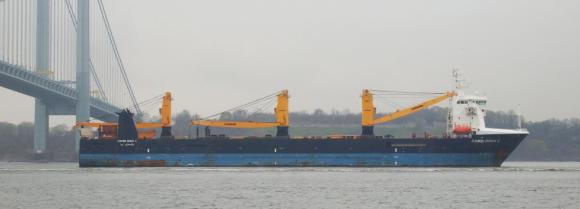
Photo: Will Van Dorp
In early April, the Hamburger Abendblatt newspaper reported that the heavy-lift ship Combi Dock 1 will carry windjammer Peking home to Germany to restored in its original home-port of Hamburg for restoration. Last Friday, Will Van Dorp posted photos on his Tugster blog of the arrival of Combi Dock 1 in New York harbor. The Peking‘s departure may be imminently on the horizon.
Peking was built in 1911 at the Blohm & Voss shipyard in Hamburg for the German ship owner, F. Laeisz, one of the famous Flying P Liners, which were among the last of the great sailing ships to round Cape Horn carrying cargo. The windjammer was a museum ship at New York’s South Street Seaport fro over 40 years and left the Seaport last September. In the mean time she has been in Caddell Dry Dock in Staten Island being made ready for the voyage to Hamburg. The German government is reported to have set aside 26 million Euros for the transportation and restoration of the historic ship.
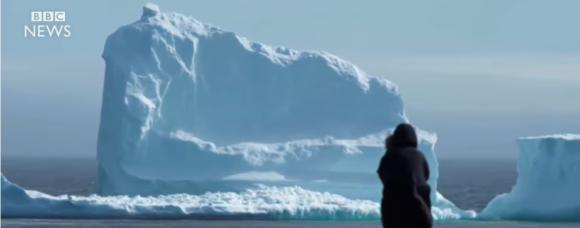 Hundreds of icebergs have drifted into major shipping lanes off Newfoundland, forcing ships to go far out of their way to steer clear of the massive ice mountains.
Hundreds of icebergs have drifted into major shipping lanes off Newfoundland, forcing ships to go far out of their way to steer clear of the massive ice mountains.
“It’s the only place in the world where icebergs intersect in a major shipping lane like that,” Gabrielle McGrath, commander of the United States Coast Guard International Ice Patrol, told the Star.com from her office in New London, Conn. “The ships are having to go out of their way to get around that iceberg limit … so it’s taking them a lot longer to get across the Atlantic.”
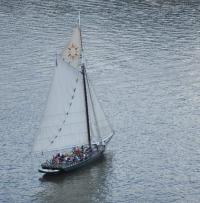 The sloop Clearwater has been sailing since 1969, spreading a message of caring for the environment and for restoring clean water to our rivers, streams and oceans. Now that clean water is again under attack by the new administration, the replica Hudson River sloop will be sailing to Washington DC with an expected arrival of June 18.
The sloop Clearwater has been sailing since 1969, spreading a message of caring for the environment and for restoring clean water to our rivers, streams and oceans. Now that clean water is again under attack by the new administration, the replica Hudson River sloop will be sailing to Washington DC with an expected arrival of June 18.
The mission of the sail is to carry a “cargo of concern” felt by New Yorkers and Americans alike for clean water and science-based federal water policy. The Clearwater will be joined by representatives of various environmental groups and state, county and local officials as they carry their message to the nation’s capital.
The non-profit organization which built the Clearwater was founded by activist and folks singer Pete Seeger and his wife Toshi Seeger. The Seegers and the Clearwater organization played a pivotal role in the passage of the Clean Water Act of 1972. The Clean Water Act (CWA) is still the primary federal law in the United States governing water pollution.
From the Clearwater website:
The Hudson River Sloop Clearwater is sailing to our nation’s capital to deliver a message from our members and supporters- in the Hudson Valley and across the country- that we… Continue reading
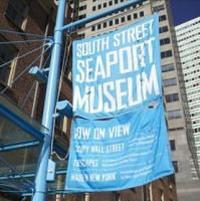 New York can be a tough town. Despite rough and tumble struggles over real estate, the vagaries of city politics, economic downturns, and not the least, being struck head-on my a monster hurricane which sent a 10′ storm surge through its buildings, the South Street Seaport Museum has not only survived, but is thriving. They have recently completed an incredible restoration of the 1885 windjammer Wavertree, the largest iron sailing vessel afloat, and are rebuilding their shore-side exhibits. And this Saturday, April 29th, the South Street Seaport is celebrating the beginning of its second 50 years with a community celebration from 11am to 5pm.
New York can be a tough town. Despite rough and tumble struggles over real estate, the vagaries of city politics, economic downturns, and not the least, being struck head-on my a monster hurricane which sent a 10′ storm surge through its buildings, the South Street Seaport Museum has not only survived, but is thriving. They have recently completed an incredible restoration of the 1885 windjammer Wavertree, the largest iron sailing vessel afloat, and are rebuilding their shore-side exhibits. And this Saturday, April 29th, the South Street Seaport is celebrating the beginning of its second 50 years with a community celebration from 11am to 5pm.
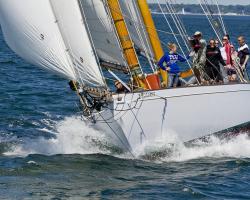 Happy birthday to Mystic Seaport‘s schooner Brilliant! On April 23, 1932, the 61′ schooner was launched from the yard of Henry B. Nevins at City Island, New York. Now 85 years later, she is still sailing and still a beauty.
Happy birthday to Mystic Seaport‘s schooner Brilliant! On April 23, 1932, the 61′ schooner was launched from the yard of Henry B. Nevins at City Island, New York. Now 85 years later, she is still sailing and still a beauty.
She was built for Walter Barnum, who raced her extensively. In World War II, she served as an anti-submarine picket boat. She was donated to the Mystic Seaport Museum, in 1953, where she has served as an offshore classroom for the the museum’s education programs.
Sailing aboard Brilliant, people of all ages have the opportunity to learn about sailing on one of the finest wooden schooners ever built. Since she was donated to the museum, Brilliant has sailed the equivalent of five times around the earth, with more than 9,000 students setting her sails and steering her course. WoodenBoat Magazine described Brilliant as one of the 100 most beautiful classic boats in existence and as “one of the best maintained and sailed classic yachts in the country — if not the world.”
 If you are near New York harbor tomorrow and have the chance, head on over to the The Noble Maritime Collection at the Snug Harbor Cultural Center between 2 PM and 5 PM tomorrow, April 22, for a free concert celebrating the release of a new CD, “Songs of the Snug Harbor Sailors,” featuring Liverpool’s own Hughie Jones, with Bob Wright, Bob Conroy, Frank Woerner, Frank Hendricks, Houseboat Jimmie Visone, Chrissie Jones, and Jan Christensen. Copies of the CD, and others, will be available for sale. Unfortunately, I will be away, but it should be a great concert with wonderful performers. Don’t miss it if you have the chance.
If you are near New York harbor tomorrow and have the chance, head on over to the The Noble Maritime Collection at the Snug Harbor Cultural Center between 2 PM and 5 PM tomorrow, April 22, for a free concert celebrating the release of a new CD, “Songs of the Snug Harbor Sailors,” featuring Liverpool’s own Hughie Jones, with Bob Wright, Bob Conroy, Frank Woerner, Frank Hendricks, Houseboat Jimmie Visone, Chrissie Jones, and Jan Christensen. Copies of the CD, and others, will be available for sale. Unfortunately, I will be away, but it should be a great concert with wonderful performers. Don’t miss it if you have the chance.
 Tropical Storm Arlene has formed in the mid-Atlantic between Bermuda and the Azores, becoming only the second named tropical storm in history to form in the month of April. The only previous tropical to form so early was Anna in 2003. Arlene’s maximum sustained winds were near 45 mph, with higher gusts, the National Hurricane Center said. It was located about 815 miles west of the Azores. The system poses no threat to land and is forecast to dissipate later today. Hurricane season officially starts on June 1.
Tropical Storm Arlene has formed in the mid-Atlantic between Bermuda and the Azores, becoming only the second named tropical storm in history to form in the month of April. The only previous tropical to form so early was Anna in 2003. Arlene’s maximum sustained winds were near 45 mph, with higher gusts, the National Hurricane Center said. It was located about 815 miles west of the Azores. The system poses no threat to land and is forecast to dissipate later today. Hurricane season officially starts on June 1.
What does the early tropical storm activity mean for the hurricane season? Continue reading
 If you are in Manhattan next Monday night, April 24, feel free to stop by the meeting of the New York Ship Lore and Model Club. Stephen Hopkins and I will be giving a joint presentation on three remarkable ships. I will discuss two amazing yet radically different ships which set off on their maiden voyages in 1845 — the extreme clipper Rainbow and the luxury steamer SS Great Britain. Following my comments, Stephen Hopkins, author of “Red Jacket — the Life and Times of a Maine Clipper Ship,” will speak about his new book and answer questions about the ship that was one of the largest and finest of all clippers.
If you are in Manhattan next Monday night, April 24, feel free to stop by the meeting of the New York Ship Lore and Model Club. Stephen Hopkins and I will be giving a joint presentation on three remarkable ships. I will discuss two amazing yet radically different ships which set off on their maiden voyages in 1845 — the extreme clipper Rainbow and the luxury steamer SS Great Britain. Following my comments, Stephen Hopkins, author of “Red Jacket — the Life and Times of a Maine Clipper Ship,” will speak about his new book and answer questions about the ship that was one of the largest and finest of all clippers.
The Monday meeting is at 7:30PM at 79 Walker Street, 5th floor. Admission is free.
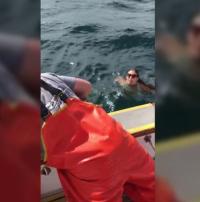 I guess if you are going to be stupid, it is also good to be lucky. A few days ago, two kayakers, a man and a woman, paddled out several miles into the Pacific ocean off Goleta, CA, 15 miles west of Santa Barbara. They ended up in the water after their kayak swamped and capsized. Neither was wearing a personal flotation devices (PFD), which are called life-savers for a reason. Fortunately for the hapless paddlers, they were spotted by Stardust, a charter sports-fishing boat. Unlike the kayakers, the crew on Stardust knew what they were doing and rescued the kayakers from the water.
I guess if you are going to be stupid, it is also good to be lucky. A few days ago, two kayakers, a man and a woman, paddled out several miles into the Pacific ocean off Goleta, CA, 15 miles west of Santa Barbara. They ended up in the water after their kayak swamped and capsized. Neither was wearing a personal flotation devices (PFD), which are called life-savers for a reason. Fortunately for the hapless paddlers, they were spotted by Stardust, a charter sports-fishing boat. Unlike the kayakers, the crew on Stardust knew what they were doing and rescued the kayakers from the water.
In a phone interview with a local TV station, Jason Diamond, one of the owners of the Stardust, credited his crew, Larry Spurlock, Christian Geisler as well as Cory Scott and Lewis Turner, for making the heroic ocean rescue roughly three miles out from Devereaux and Isla Vista — not far from Platform Holly. “They were out there,” Diamond said, referring to the kayakers. “No lifejackets.”
“We do these drills all the time,” Diamond said. “That was just a good textbook save. Those guys did a great job.”
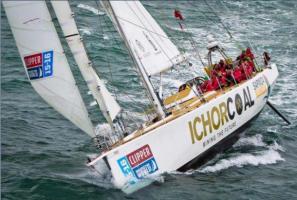 The Clipper Round the World Race is a race around the world held every two years sailed with a professional captain and paying amateur crews. In nine races starting in 1996, the contests were sailed without loss of life. That tragically changed in the 2015-2016 race, when two sailors, Andrew Ashman, 49, and Sarah Young, 40, both died in separate incidents on the same boat, IchorCoal. Last week, the UK’s Marine Accident Investigation Board (MAIB) released their report on the two deaths. The report recommended that a second professional seafarer be aboard the boats during the race, that man-overboard drills be increased and that the use and strength of certain high strength lines aboard the boats should be re-evaluated.
The Clipper Round the World Race is a race around the world held every two years sailed with a professional captain and paying amateur crews. In nine races starting in 1996, the contests were sailed without loss of life. That tragically changed in the 2015-2016 race, when two sailors, Andrew Ashman, 49, and Sarah Young, 40, both died in separate incidents on the same boat, IchorCoal. Last week, the UK’s Marine Accident Investigation Board (MAIB) released their report on the two deaths. The report recommended that a second professional seafarer be aboard the boats during the race, that man-overboard drills be increased and that the use and strength of certain high strength lines aboard the boats should be re-evaluated.
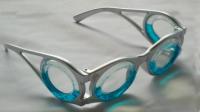 Charles Darwin once wrote, “If it was not for sea-sickness, the whole world would be sailors.” Some of us are more susceptible to mal de mer than others. Apparently, Darwin was very prone to sea sickness. From my own experience, I am fairly lucky, falling somewhere about the middle of the misery spectrum — neither quite immune nor wholly incapacitated by sea sickness. In a few weeks, I will be setting off an a five day delivery trip on my new/old boat with a new crew, so I will be sure that we have all the standard anti-sea-sickness “remedies” — a stock of saltine crackers, apples, ginger-ale and, if need be, Bonine. Often the best defense against motion sickness is just keeping an eye on the horizon. I wonder, however, if I am being too old-school in my approach. Perhaps, we should consider anti-sea sickness googles and glasses.
Charles Darwin once wrote, “If it was not for sea-sickness, the whole world would be sailors.” Some of us are more susceptible to mal de mer than others. Apparently, Darwin was very prone to sea sickness. From my own experience, I am fairly lucky, falling somewhere about the middle of the misery spectrum — neither quite immune nor wholly incapacitated by sea sickness. In a few weeks, I will be setting off an a five day delivery trip on my new/old boat with a new crew, so I will be sure that we have all the standard anti-sea-sickness “remedies” — a stock of saltine crackers, apples, ginger-ale and, if need be, Bonine. Often the best defense against motion sickness is just keeping an eye on the horizon. I wonder, however, if I am being too old-school in my approach. Perhaps, we should consider anti-sea sickness googles and glasses.
Anti-sea sickness googles and glasses have been around for almost a decade, yet they haven’t seemed to have caught on. Part of the issue may be expense. The other consideration is that the most effective googles simply look funny.
 Granny is dead. In August of last year, we posted Orca “Granny,” 105 Years Old, Still Swimming the Pacific about the oldest member of the ” J” pod of Puget Sound orcas, and also the known living orca. Sadly, in January, the whale dubbed J2 by researchers, but nicknamed “Granny,” was no longer seen swimming with her pod and is presumed to have died. Even orcas whales cannot live forever, but nevertheless, Granny’s passing may be a sign of a much greater problem for orcas, also known as killer whales, in the Pacific Northwest. Because of a decrease in wild salmon, the orcas may be starving. Alarmingly, a similar problem appears to be facing orcs in the Antarctic where a decrease in the seal population may be threatening orca survival.
Granny is dead. In August of last year, we posted Orca “Granny,” 105 Years Old, Still Swimming the Pacific about the oldest member of the ” J” pod of Puget Sound orcas, and also the known living orca. Sadly, in January, the whale dubbed J2 by researchers, but nicknamed “Granny,” was no longer seen swimming with her pod and is presumed to have died. Even orcas whales cannot live forever, but nevertheless, Granny’s passing may be a sign of a much greater problem for orcas, also known as killer whales, in the Pacific Northwest. Because of a decrease in wild salmon, the orcas may be starving. Alarmingly, a similar problem appears to be facing orcs in the Antarctic where a decrease in the seal population may be threatening orca survival.
A fascinating short video by the BBC. Apparently, the mobula rays which make the biggest slash when leaping from the ocean have the greatest chance of finding a mate. Often referred to as “devil rays”, “flying mobula” or simply “flying rays”, they grow to up to 17 ft from wing tip to wing tip and can weigh over a ton. They are capable of truly impressive belly flops.
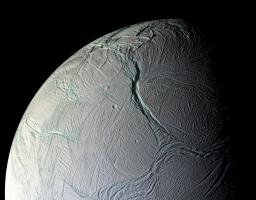 NASA scientists this week, made an exciting announcement. They have discovered the necessary chemical mix to potentially support life in the sea beneath a polar ice cap of Saturn’s moon, Enceladus. What they have observed on Enceladus is similar to the characteristics of deep-sea hydrothermal vents on Earth.
NASA scientists this week, made an exciting announcement. They have discovered the necessary chemical mix to potentially support life in the sea beneath a polar ice cap of Saturn’s moon, Enceladus. What they have observed on Enceladus is similar to the characteristics of deep-sea hydrothermal vents on Earth.
As the spacecraft Cassini passed by Enceladus, it recorded the chemical contents of gas plumes from the icy surface near the south pole. The plumes were primarily composed of water erupting through cracks in the surface ice. They are believed to originate from hydro-thermal vents in the Enceladus seafloor. In the latest recordings, the spacecraft Cassini also found significant hydrogen in the mix. Hydrogen is an important component to provide the energy to support life. With the addition of hydrogen, Enceladus appears to have all the right chemical building blocks for life. “Now, Enceladus is high on the list in the solar system for showing habitable conditions,” said Hunter Waite, leader of the Cassini Ion and Neutral Mass Spectrometer team at the Southwest Research Institute in San Antonio and lead author of the Enceladus study, to CNN.
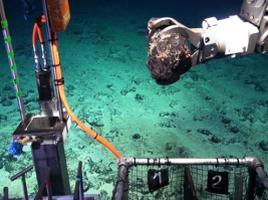 Deep-sea mining has long been a controversial subject. For the last 50 years, proponents have called for the mining of silver, gold, copper, manganese, cobalt, and zinc from the seafloor, while environmentalists have argued that seabed mining should not be permitted because of the potential damage to deep-sea ecosystems. So far, no actual commercial mining has taken place although at least one project is scheduled to start in 2018. Recently a new discovery has, perhaps somewhat paradoxically, renewed interest in undersea mining in order to help produce green energy.
Deep-sea mining has long been a controversial subject. For the last 50 years, proponents have called for the mining of silver, gold, copper, manganese, cobalt, and zinc from the seafloor, while environmentalists have argued that seabed mining should not be permitted because of the potential damage to deep-sea ecosystems. So far, no actual commercial mining has taken place although at least one project is scheduled to start in 2018. Recently a new discovery has, perhaps somewhat paradoxically, renewed interest in undersea mining in order to help produce green energy.
Tellurium is a rare metallic element, number 52 on the Periodic Table, which is a key component used in the fabrication of advanced solar panels. The BBC recently reported that British scientists exploring an underwater mountain in the Atlantic Ocean have discovered a treasure trove of rare minerals, including a particularly rich source of tellurium. The tellurium was reported to be in concentrations 50,000 times higher than in deposits on land. In addition to the tellurium, The rock samples also contained rare earth elements that are used in wind turbines and electronics.
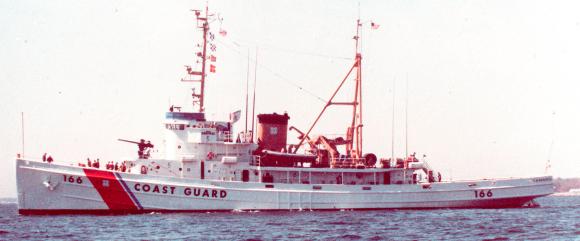 Last October, we posted that the USCG Cutter Tamaroa, ex-USS Zuni, was to be reefed by the end of the month. The 205-foot ex-fleet ocean/salvage tug and ex-Coast Guard Cutter was to be sunk as part of an artificial reef about 26 miles off Cape May, NJ. Sinking the ship on October 30th was to coincide with the the 25th anniversary of the “Perfect Storm” of 1991. The sinking was delayed, however, awaiting test results to document that the 73 year old ship was free of cancer-causing PCBs. The tests took took longer than had been originally anticipated. Now, the storied ship will will finally be sent to the bottom next Tuesday, weather permitting.
Last October, we posted that the USCG Cutter Tamaroa, ex-USS Zuni, was to be reefed by the end of the month. The 205-foot ex-fleet ocean/salvage tug and ex-Coast Guard Cutter was to be sunk as part of an artificial reef about 26 miles off Cape May, NJ. Sinking the ship on October 30th was to coincide with the the 25th anniversary of the “Perfect Storm” of 1991. The sinking was delayed, however, awaiting test results to document that the 73 year old ship was free of cancer-causing PCBs. The tests took took longer than had been originally anticipated. Now, the storied ship will will finally be sent to the bottom next Tuesday, weather permitting.
Tamaroa may be best known for rescuing the crew of the yacht Satori, as well as the crew of a downed Air National Guard helicopter during the “Perfect Storm”, as described in Sebastian Junger’s book of the same name.
Captains on the new Citywide Ferry service in New York harbor are receiving training on a state-of-the-art simulator at SUNY Maritime College at Fort Schyler.
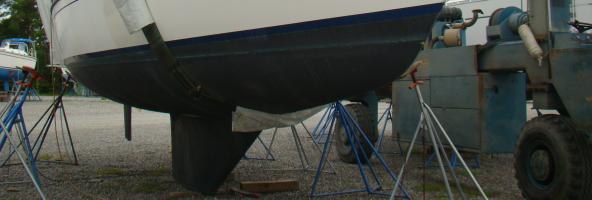 I am sure that I am not the only one who really does not like anti-fouling bottom paint. By definition, anti-fouling bottom paint is a biocide — it kills life — which is fine and dandy if that life is a barnacle. It is not great as I wonder how much dust is getting past my respirator as I prep the bottom of the boat between seasons. I recently learned about ultrasonic anti-fouling systems. I know that I am a bit late to the party as it has been around commercially for at least five or six years now, but it doesn’t seem to be widely accepted quite yet.
I am sure that I am not the only one who really does not like anti-fouling bottom paint. By definition, anti-fouling bottom paint is a biocide — it kills life — which is fine and dandy if that life is a barnacle. It is not great as I wonder how much dust is getting past my respirator as I prep the bottom of the boat between seasons. I recently learned about ultrasonic anti-fouling systems. I know that I am a bit late to the party as it has been around commercially for at least five or six years now, but it doesn’t seem to be widely accepted quite yet.
